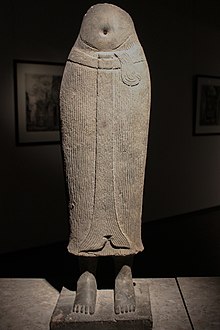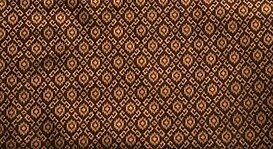Sampot

Asampot(Khmer:សំពត់/sɑmpʊət/Khmer pronunciation:[sɑmpɔt]),[1]a long, rectangular cloth worn around the lower body, is a traditional dress inCambodia.[2]It can be draped and folded in several different ways. The traditional dress is similar to thedhotiofSouthern Asia.It is also worn in the neighboring countries ofLaosandThailandwhere it is known aspha nung(Thai:ผ้านุ่ง[pʰâːnûŋ]).[3]
Origins
[edit]The sampot dates back to theFunan erawhen a Cambodian king ordered the people of his kingdom to wear the sampot at the request of Chinese envoys.[4]It is similar to thelungianddhotiworn in theIndian subcontinent,thelongyiworn inBurma,and thesarongworn inmaritime Southeast Asia.Silkweaving was an important part of Cambodia's cultural past. People fromTakéo Provincehave woven silk since the Funan era and records, bas-reliefs, andZhou Daguan's report have shown that looms were used to weave sompots since ancient times.[4]
Complex methods and intricate patterns have been developed to make the cloth, one of which is the hol method which involves dyeing patterns on silk before weaving. What remains unique to Cambodian weavers is the uneven twill technique. The reason they adopted such an unusual method remains unclear.[5]
However, little is known about theOld Khmervocabulary for these fabrics, and if the sampot today was simply changed over time from the original Angkorian textiles. The ancientbas-reliefshowever provide a complete look at what fabrics were like, down to patterns and pleats. Silk woven cloths are used inweddingsandfuneralsand for decoration of temples.[6]
-
Modernsampot samloy
-
9-10th century Khmer statue wearing another design ofsampot
-
Foldedsampot
Textiles
[edit]There are three important silk textiles in Cambodia. They include the ikat silks (chong kiet in Khmer), or hol, the twill-patterned silks and the weft ikat textiles.[citation needed]Patterns are made by tying natural andsynthetic fiberson the weft threads and then it is dyed. It is repeated for different colors until the patterns firm and cloth is woven.[citation needed]
Traditionally, five colors are used, predominantly red, yellow, green, blue and black.[citation needed]The Sompot Hol is used as a lower garment and as the sompot chang kben. The Pidan Hol is used as a ceremonial hanging used for religious purposes.
Variations
[edit]There are many variations of the sampot, each is worn according to class. The typical regular sampot, known also as thesarongis typically worn by men and women oflower class.It measures approximately one and a half meters and both ends are sewn together. It is tied to secure it on the waist.[citation needed]
- TheSampot Phamuongសំពត់ផាមួង /sɑmpʊət pʰaa muəŋ/[7]are many different variations of traditional Khmer textiles. They are single colored and twill woven. There are currently 52 colors used in Sampot Phamuong. The Phamuong Chorabap is a luxurious fabric using up to 22 needles to create. Phamuong variation are rabak, chorcung, anlounh, kaneiv and bantok. It usually uses floral and geometric motifs. The mostvaluedsilk used to create the Phamuong is Cambodian yellowsilk,known for its fine quality in the region. Newdesignsdraw inspiration from ancient patterns on old silk.
- TheSampot Holសំពត់ហូល /sɑmpʊət hool/[8]is a typical traditional textile. There are two kinds of Sampot Hol, one is a wrapping skirt that uses a technique called chang kiet and twill weave. Influenced by the Indian patola, it developed patterns and techniques over the centuries to become a genuine Khmer art style. The sampot hol has over 200 patterns combined with three to five colors, yellow, red, brown, blue, and green. There are four variations, sampot hol, sompot hol por, sampot hol kben, and sampot hol ktong. Patterns are usually geometric motifs, animals, and flower motifs.
In daily life
[edit]
The sompot is deeply rooted in Cambodia. Even though theFrenchbrought a degree ofWesternizationto Cambodia, Cambodians continued to wear the sompot.Royaltyand government officials used thesampot chang kbenwith a formal jacket. The sompot chong kben and sompot phamuong are still worn by Cambodians today during special occasions, and rural and poor Khmers still prefer it over Western-style clothing for its comfort.
The material used by poor and rural Cambodians is not hand-woven silk but printedbatik-patternedcloth imported fromIndonesia.It is still popular with both men and women alike and is regarded by the people of Cambodia as theirnational garment.[citation needed]
See also
[edit]Further reading
[edit]- Gillian Green (2003).Traditional textiles of Cambodia.Bangkok: River Books.ISBN974-8225-39-9.
References
[edit]- ^"SEAlang Dictionary".sealang.net.Retrieved2023-10-11.
- ^Emma C. Bunker,Douglas Latchford.Adoration and glory: the golden age of Khmer art.Art Media Resources, 2004, p. 35
- ^James C. Ingram.Economic change in Thailand 1850-1970.Stanford University Press, 1971, p. 10 By
- ^abGreen, Gillian. "Textiles at the Khmer Court".Arts of Asia30 (4): 82–92.
- ^Textiles of the Highland Peoples of Burma, Vol. 2: The Northern Mon-Khmer, Rawang, Upland Burmish, Lolo, Karen, Tai, and Hmong-Mien-Speaking Groups,2005. Michael C. Howard. White Lotus Co Ltd.,ISBN978-9744800749
- ^Joachim Schliesinger. Ethnic Groups of Cambodia Vol 2: Profile of Austro-Asiatic-Speaking Peoples. 312 pag.ISBN163-3232379,ISBN978-1633232372
- ^"SEAlang Dictionary".sealang.net.Retrieved2023-10-11.
- ^"SEAlang Dictionary".sealang.net.Retrieved2023-10-11.







